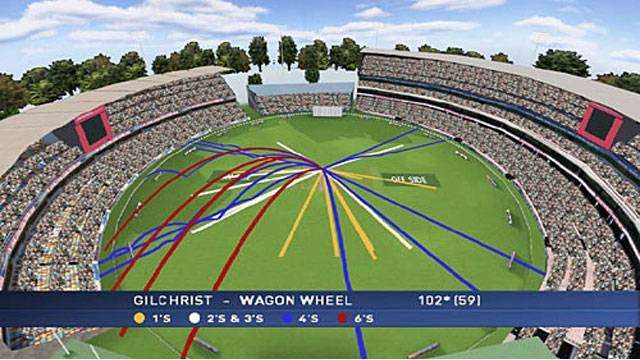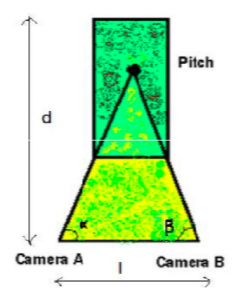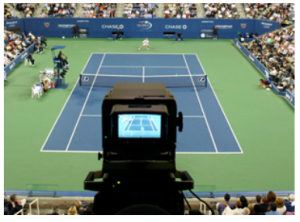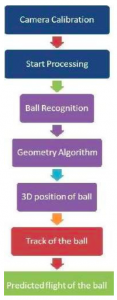
Hawkeye has made a huge difference since it was invented
Why was Hawkeye invented?
- Sport is very important to the public and is also very important from a commercial point of view. As a result sport needs to be as fair as possible and it is important to stop referees from making mistakes.
- Human error began to play a vital role in decision making at decisive moments.
- Various sports decided that technology was needed to minimise the chances of human error in such decision making.
- Sports development coaches were keen to help players to study their past games and improve.
Who invented Hawkeye?
- It was developed by engineers at Roke Manor Research Ltd in Romsey, England, in 2001. The patent is held by Paul Hawkins and David Sherry.
- The system was first used during a Test match between Pakistan and England at Lord’s Cricket Ground, on 21 April 2001.
- It was first used in Tennis in the 2006 US Open.

How does it work?
Hawk-Eye system is based on the principle of ‘triangulation’. Triangulation is the process of finding the location of a point by measuring the angles between the point and other points which are fixed.

The Hawk-Eye system consists of two significant parts:
- The Tracking System which contains a camera and speed gun, and
- The Video Replay System, which tracks the data to help referees make decisions, and help coaches and players to analyse their game.
In cricket, the system automatically calculates the following information:
- The speed of the ball leaving the bowler’s hand.
- The swing of the ball from the bowler’s hand to its ‘pitch’, or bounce
- How much the ball has bounced
- How much the ball spun sideways off the wicket
- A prediction of where the ball would have passed the stumps
 In tennis:
In tennis:
- Hawk-Eye cameras are placed high above the court to track the ‘trajectory’ (or path) of the ball.
- It can point out the bounce of the ball up to the precision of 3.6mm.
- The cameras record the movement of ball at the rate of 100 frames per second.
- The Hawk-Eye System can incorporate more video replay cameras for analysis from different angles, which can be controlled remotely.
- The video is captured and stored digitally on hard disks.
The science behind Hawkeye
 The process is started with some calibration of the cameras. This registers the distance at which cameras will see the pitch, and the ball.
The process is started with some calibration of the cameras. This registers the distance at which cameras will see the pitch, and the ball.
Advantages:
- It gives a prediction as accurate as 99.99 percent.
- It’s a very effective system which works in real time.
- It minimises the chances of human error in decision making.
- It helps players to study their past games and improve.
Disadvantages:
- The system is very expensive.
- The system needs complex arrangements.
- Sometimes Hawk-Eye struggles with predicting the trajectory of a cricket ball after it bounces while spinning.
- Sometimes it challenges umpires; dignity.
Conclusion
- This technology helps referees and other umpires to make the correct decisions in any kind of game.
- It is a great tool which can be used by players and coaches to analyse previous games and come up with strategies for future ones.
- However it is very difficult and complicated to set up, and very expensive.
- This means it can only really be used by very big and important sporting organisations, and can’t really be used by smaller sports or amateur teams.
- If we can find a way of making Hawk-Eye cheaper and easier to use, it will be very useful for many sports.
Hawkeye – a Timeline
The timeline below outline some of the significant moments in Hawk-Eye’s history, and demonstrates just how quickly the company has grown.
- September 2014: Hawk-Eye is famously used to decide the outcome of the 2014 All-Ireland Senior Hurling Final, when a stoppage-time free from Tipperary’s John O’Dwyer – the last puck of the game – is referred to Hawk-Eye. The system shows that the free went just wide, meaning the game ended in a draw and the All-Ireland went to a replay, won by Kilkenny.
- June 2013 : The GAA officiating system is used for the first time at Croke Park, Dublin.
- May 2013 : The Premier League confirms the use of Hawk-Eye’s Goal-Line Technology at all 20 clubs for the 2013-2014 season.
- October 2012: Hawk-Eye gains official authorisation from FIFA to install their goal-line technology systems worldwide.
- July 2012 : Two tennis line-calling systems are used at the London 2012 Olympic Games
- July 2012 : The football system qualifies as an official FIFA licensee of goal-line technology.
- May 2012 : The football simulator makes its debut at the Champions League Final, Munich.
- March 2012: Tennis player and ball tracking data is used as a coaching aid at the Miami Masters 1000 and SAP Open events. For the first time, players were able to immediately access data from their matches, including new innovations such as spin and distance covered by each player.
- January 2012: Hawk-Eye is one of only two companies to successfully pass Phase 1 of FIFA’s approval process for Goal-Line Technology (GLT) in football. The IFAB approved Hawk-Eye to take part in Phase 2 testing, which further assessed the reliability and accuracy of the system under realistic match conditions.
- January 2012 : The Australian Open Tennis extends the use of Hawk-Eye to three of its main match courts.
- August 2011 : The US Open uses the electronic line calling system across four courts.
- June 2011 : The All-England Championships at Wimbledon become the first Grand Slam to use the electronic line calling system across four courts.
- March 2011:
Hawk-Eye is bought by Sony as a flagship brand within its sports business.
The Indian Wells Masters 1000 series event in California become the first event to boast Hawk-Eye on all eight of its match courts. - February 2011:
The cricket system is used for Decision Review System during the Cricket World Cup in India, the third occasion that Hawk-Eye has featured at this level of competition.
A permanent installation of cricket tracking cameras and HD video cameras are installed at the ICC Global Cricket Academy, Dubai, for year-round use by players and coaches. - November 2010 : Fox Sports Australia utilise Hawk-Eye tracking technology for their domestic cricket coverage.
- February 2010 : The Hong Kong Cricket Club finalises installation of a tracking and HD video system across three coaching lanes.
- August 2008 : Hawk-Eye becomes involved in the Olympic movement for the very first time, with the tennis systems used on the two show courts at the Beijing Games.
- October 2007 : The MCC World Cricket Committee announces that Hawk-Eye will be used in trials to determine a new Decision Review System in Test Cricket.
- September 2007: Hawk-Eye sends three units to the first ICC World Twenty20 Championships in South Africa.
- August 2007 : Hawk-Eye’s football goal-line technology passes the first stage of testing by the FA Premier League at Reading FC’s training ground.
- June 2007 : Hawk-Eye is used officially at the Wimbledon Championships, the third Grand Slam event to implement the technology. Players on Centre Court and Court Number One are allowed three incorrect challenges per set, with an additional challenge if the set goes to a tie break.
- February 2007: The IFAB (International Football Association Board) – which sets the rules of soccer – gives its approval for Hawk-Eye’s football development work.
- January 2007
: The Rod Laver Arena boasts new video boards as Hawk-Eye is used officially at the Australian Open. Players are allowed two incorrect challenges per set, with the benefit of an additional challenge if the set goes to a tie-break.
Hawk-Eye agrees a contract with the English Premier League to develop goal-line technology for football (soccer). - Summer 2006: Hawk-Eye is used officially at ten US Open Series events and at World Team Tennis throughout the United States. The company’s four units culminate in the first Official Challenge system to be used at a Grand Slam tennis event at the US Open.
- June 2006 : Hawk-Eye Innovations Ltd. becomes part of the Wisden Group.
- March 2006 : Hawk-Eye is used officially at tennis’s Nasdaq-100 Open in Miami, the first Tour event to adopt the system.
- December 2005 : The Hawk-Eye Official Review Tennis system makes its debut in the Champions Tour at the Royal Albert Hall.
- October 2005 : Hawk-Eye passes stringent ITF electronic line calling testing, at the Arthur Ashe Stadium in New York. This enabled Tour events to utilise the officiating aid for the very first time.
- November 2004: Hawk-Eye wins The BCS Technology Award for Enhancement to Television Production.
- September 2004 : Jennifer Capriati’s 2-6, 6-4, 6-4 quarterfinal victory over Serena Williams at the U.S. Open thrusts tennis line-calling into the media spotlight.
- September 2003 : Hawk-Eye wins an Emmy for Outstanding Innovative Technical Achievement.
- January 2003 : Hawk-Eye makes its Grand Slam television debut at the Australian Open.
- February 2002 : Hawk-Eye is first used in tennis as part of the BBC’s Davis Cup coverage.
- September 2001: Hawk-Eye Innovations Ltd. is launched as a separate company. The tennis system receives a new impetus of development expertise.
- Spring 2001:
After eighteen months of development, Channel 4 use Hawk-Eye in their coverage of the Ashes, winning a BAFTA for Sports Innovation.
Hawk-Eye wins the Royal Television Society Award for Technical Innovation.
- Early 1999: Research begins at Roke Manor Research Ltd., a company with over thirty years of vision processing expertise. Led by Dr. Paul Hawkins and funded by The Television Corporation, the concept of ”Hawk-Eye” is born.
